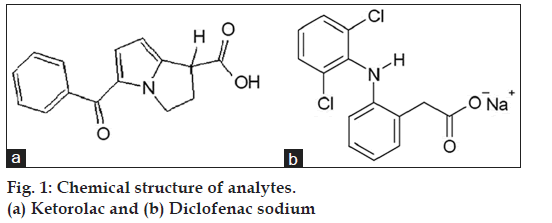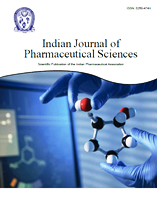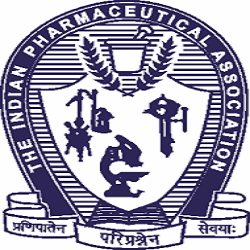- *Corresponding Author:
- Dubey SK
Department of Pharmacy, Birla Institute of Technology and Science, Pilani?333 031, India
E-mail: sunbit2000@gmail.com
| Date of Received : | 22 April 2012 |
| Date of Revised : | 24 January 2013 |
| Date of Accepted : | 05 February 2013 |
| Indian J Pharm Sci 2013;75(1):89-93 |
Abstract
A reliable, rapid and sensitive isocratic reverse phase high-performance liquid chromatography method has been developed and validated for assay of ketorolac tromethamine in tablets and ophthalmic dosage forms using diclofenac sodium as an internal standard. An isocratic separation of ketorolac tromethamine was achieved on Oyster BDS (150×4.6 mm i.d., 5 μm particle size) column using mobile phase of methanol:acetonitrile:sodium dihydrogen phosphate (20 mM; pH 5.5) (50:10:40, %v/v) at a flow rate of 1.0 ml/min. The eluents were monitored at 322 nm for ketorolac and at 282 nm for diclofenac sodium with a photodiode array detector. The retention times of ketorolac and diclofenac sodium were found to be 1.9 min and 4.6 min, respectively. Response was a linear function of drug concentration in the range of 0.01-15 μg/ml (R2 =0.994; linear regression model using weighing factor 1/x2 ) with a limit of detection and quantification of 0.002 μg/ml and 0.007 μg/ml, respectively. The % recovery and % relative standard deviation values indicated the method was accurate and precise.
Keywords
Diclofenac sodium, ketorolac tromethamine, method validation, reverse phase high‑performance liquid chromatography‑PDA, weighted regression
Ketorolac tromethamine, chemically, 5‑benzoly ‑2, 3‑dihydro‑1H‑pyrrolizine‑1‑carboxylicacid, 2‑(hydroxymethyl)‑1,3‑propanediol (fig. 1a), is a nonsteroidal antiinflammatory drug which exhibits pronounced analgesic and moderate antiinflammatory activity [1‑4]. It is indicated for the short‑term management of moderate to severe pain. Literature survey showed that very few analytical methods have been reported for the estimation of ketorolac in single or in combination such as spectrophotometric [5], flow injection analysis [6], high‑performance liquid chromatography (HPLC) [7‑15], high‑performance thin layer chromatography (HPTLC) [16] and gas chromatography‑mass spectrometry [17], which are either less economical or less sensitive. For routine analysis, a simple, rapid and most sensitive analytical method is preferred. The objective of the present study is to develop a simple, reliable, rapid and sensitive analytical method with better detection range, for the estimation of ketorolac tromethamine in bulk and in dosage forms using diclofenac sodium as an internal standard (fig. 1b). The developed method was validated as per International Conference on Harmonization (ICH) guidelines and suitable statistical tests were performed on validation data.
Materials and Methods
Ketorolac tromethamine reference standard was provided by Torrent Pharmaceuticals, Ahmedabad, India. Diclofenac sodium was procured from Aarti Drugs Ltd., Mumbai, India, tablets of ketorolac tromethamine, Ketorol DT, with a 10 mg label claim, manufactured by Dr. Reddys Laboratories Ltd., and eye drops, Acular LS with a labelled claim of 4 mg/ml, manufactured by allergan were procured from local market. HPLC grade acetonitrile, methanol and analytical grade hydrochloric acid, sodium hydroxide pellets and sodium dihydrogen phosphate were obtained from Merck India Limited, Mumbai, India. High purity deionized water was prepared by TKA smart2pure, Niederelbert, Germany purification system. In addition, an electronic balance (AG‑135, Mettler‑Toledo, Germany), pH meter (pH tutor, Eutech Instruments, Singapore), a sonicator (Toshiba, New Delhi) were used.
Chromatography
The chromatographic system used to perform development and validation of this method consisted of an LC‑20AD binary pump, an SPD‑M20A photodiode array detector, SIL 20 AC auto sampler, connected to a communication and Bus module CBM 20A (Shimadzu, Kyoto, Japan). Chromatographic analysis was performed on Oyster BDS (150×4.6 mm i.d., 5 μm particle size) column using mobile phase at a flow rate of 1.0 ml/ min in isocratic mode. The mobile phase consists of methanol:acetonitrile:sodium dihydrogen phosphate (20 mM, pH 5.5) (50:10:40, v/v). The eluent was monitored using photo diode array (PDA) detector at wavelengths 322 nm and 282 nm for ketorolac and diclofenac sodium, respectively. The column was maintained at ambient temperature and injection volume of 50 μl was used.
Preparation of stock solutions and calibration curve
Stock solutions were prepared by weighing 5 mg and 25 mg of ketorolac and diclofenac sodium individually and transferred into two separate 50 ml volumetric flasks. Volumes were made up to the mark with methanol to obtain a solution containing 100 μg/ml of ketorolac and 500 μg/ml of diclofenac sodium. Appropriate aliquots of ketorolac stock solution were taken in different 10 ml volumetric flasks and to each volumetric flask 100 μl of diclofenac stock solution were added then diluted up to the mark with mobile phase to obtain final concentrations of 0.01‑15 μg/ml of ketorolac each containing 5 μg/ml of internal standard. The solutions were analysed and chromatograms were recorded. Calibration curves were constructed by plotting average peak areas ratios of ketorolac and diclofenac sodium versus concentration of analyte and regression equation was computed.
Analysis of marketed formulations
Two tablets (Ketorol DT, 10 mg) were transferred into a 100 ml volumetric flask; 10 ml of water was added and sonicated for 10 min. After sonication 40 ml of methanol was added and again sonicated for 10 min and finally volume was made up to the mark by adding methanol. This solution was centrifuged for 10 min. To 5 ml of above supernatant, 5 ml of working solution of internal standard (100 µg/ml) was added and the volume was made up to 50 ml with mobile phase. From this solution 0.5 ml was taken and made up to 1 ml with mobile phase and this solution was analysed.
Five millilitres of ophthalmic solution (Acular LS, 4 mg/ml, 5 ml) was transferred into 100 ml volumetric flask and the volume was made by using methanol. Then 5 ml of above solution was taken, to that 5 ml of working solution of internal standard (100 µg/ml) was added and the volume was made up to 50 ml with mobile phase. From this solution 0.5 ml was taken and made up to 1 ml with mobile phase and it was analysed.
Method validation
The method of analysis was validated as per the recommendations of ICH [18‑20] and United States Pharmacopoeia (USP) [21] for the parameters such as linearity, accuracy, precision, detection limit, quantification limit and robustness.
Linearity
For preparing the calibration curve, seven solutions containing 0.01, 0.1, 0.5, 1, 3, 5, 10 and 15 μg/ml ketorolac tromethamine were used. Each solution was injected in triplicate and linearity was evaluated by weighted linear‑regression analysis.
Accuracy
Accuracy was assessed by determining % of nominal concentration for three levels of quality control standards (lower quality control (LQC), medium quality control (MQC), high quality control (HQC) corresponds to 50 ng/ml, 4 μg/ml, 12 μg/ml, respectively). At each level, three replicates (n=3) were prepared and analysed.
Precision
Precision study was carried out for intraday and interday, by estimating the relative standard deviation for the three levels of quality control standards (LQC, MQC, HQC corresponds to 50 ng/ml, 4 μg/ml, 12 μg/ml, respectively). At each level, three replicates (n=3) were prepared and analysed.
Limit of detection and quantification
The LOD and LOQ were calculated using following formulae: LOD=3.3σ/S and LOQ=10 σ/S, where σ=standard deviation of intercept of calibration curve and S=average of the slope of the calibration curves.
System suitability
System suitability tests are an integral part of chromatographic method which is used to verify reproducibility of the chromatographic system. To ascertain its effectiveness, certain system suitability test parameters were checked by repetitively injecting the drug solution at the concentration level of 10 µg/ml.
Robustness
For robustness evaluation of HPLC method a few parameters like flow rate, different lots of solvent and pH of mobile phase were deliberately changed. One factor was changed at one time to estimate the effect. Each factor selected was changed at three levels (−1, 0, +1) with respect to optimized parameters. Robustness of the method was done at the concentration level 10 µg/ml.
Stock solution stability
Stability in solution was evaluated for the stock solution. The solutions were stored at ambient temperature without protection from light and tested after 12, 24, 36 and 48 h. The responses for the aged solution were evaluated by comparison with freshly prepared solutions.
Specificity
The specificity of the method towards the drug was established through study of resolution factor of the drug peak from the nearest resolving peak. Effect of excipients of formulation was studied, whether they interfere with the analyte.
Results and Discussion
The mobile phase of methanol:acetonitrile: sodium dihydrogen phosphate (20 mM, pH 5.5) (50:10:40, v/v), at flow rate of 1 ml/min gave two sharp, well‑resolved peaks with minimum tailing factor for analyte and internal standard. The eluent was monitored at 322 nm for ketorolac and at 282 nm for diclofenac sodium. As it is an isocratic reverse phase (RP)‑HPLC method, retention time of solutes depends on their physicochemical properties. Diclofenac sodium, used as an internal standard is acidic in nature like analyte and its pKa is equivalent to analyte’s pKa and its response was proportional to ketorolac response which is most essential. The retention times for ketorolac and diclofenac were 1.9 min and 4.6 min, respectively (fig. 2). Data analysis was conducted on the pooled data using prism software. Variance test (F‑test) used indicated the presence of heteroscedasticity in the response data.
The linear equation considered was: y=ax+b; where ‘y’ is ratio of response of ketorolac and diclofenac and ‘x’ is ketorolac concentration; a, b are slope and intercept of regression line. Weighing factors considered were 1, 1/x, 1/x2, 1/y and 1/y2. The best regression model and weighing factor was chosen according to the sum of absolute percentage relative error (% RE) values. The best model will be that which gives the least sum of the % RE across the whole concentration range. Here we applied weighted regression analysis taking 1/x2 and the weighted regression equation was y=0.3022x+0.00046. The selection of weighing factor is given in Table 1.
| Weighting factor | 1 | 1/x | 1/x2 | 1/y | 1/y2 |
|---|---|---|---|---|---|
| a±SD | 0.284±0.020 | 0.290±0.003 | 0.30±0.007 | 0.290±0.001 | 0.300±0.006 |
| b±SD | 0.025±0.003 | 0.001±0.001 | 0.0004±0.0002 | 0.0011±0.001 | 0.0004±0.0001 |
| R2 | 0.9991 | 0.9986 | 0.994 | 0.9986 | 0.9948 |
| Σ%RE | 4134.19 | 185.38 | 108.82 | 197.31 | 110.08 |
a and b are slope and intercept of regression line, respectively, SD=Standard deviation for n=3 observations, RE=Relative error
Table 1: Weighted Least Squares Regression Analysis.
The accuracy study shown that, this method was accurate (Table 2) and the precision for both intraday and interday evaluated given percentage relative standard deviation (% RSD) below 2 (Table 3). The LOD and LOQ were 0.0024 and 0.0074 µg/ml, respectively. The results for validation and system suitability test parameters are summarized in Table 4. Results for robustness evaluation are given in Table 5. Insignificant differences in peak areas and less variability in retention times observed indicates robustness of method. Stock solution stability study indicates this stock solution is stable up to 48 h which is greater than total analysis process (Table 6). Assay results for pharmaceutical dosage forms using proposed method were comparable with the corresponding labelled amounts (Table 7; figs. 3 and 4).
| Nominal conc. | Calculated conc. | % | % of nominal |
|---|---|---|---|
| (μg/ml) | (μg/ml) | Bias | conc. |
| 0.05 (LQC) | 0.05 | 0.985 | 99.015 |
| 4.0 (MQC) | 3.897 | 2.58 | 97.42 |
| 12 (HQC) | 12.004 | 0.029 | 100.029 |
n=3 observations, LQC=Lower quality control, MQC=Medium quality control, HQC=High quality control
Table 2: Validation Parameter?Accuracy of Method.
| Time | Nominal conc. | Calculated conc. | % |
|---|---|---|---|
| (μg/ml) | (μg/ml) | RSD | |
| Intraday precision | |||
| 8.30 AM | 0.05 (LQC) | 0.05 | 1.096 |
| 4.0 (MQC) | 3.897 | 1.806 | |
| 12.0 (HQC) | 12.004 | 1.48 | |
| 12.00 PM | 0.05 (LQC) | 0.051 | 0.863 |
| 4.0 (MQC) | 3.934 | 0.05 | |
| 12.0 (HQC) | 11.693 | 0.127 | |
| 5.00 PM | 0.05 (LQC) | 0.049 | 0.999 |
| 4.0 (MQC) | 3.894 | 0.961 | |
| 12.0 (HQC) | 11.915 | 0.661 | |
| Interday precision | |||
| Day 1 | 0.05 (LQC) | 0.05 | 1.096 |
| 4.0 (MQC) | 3.897 | 1.806 | |
| 12.0 (HQC) | 12.004 | 1.48 | |
| Day 2 | 0.05 (LQC) | 0.05 | 1.566 |
| 4.0 (MQC) | 3.979 | 0.414 | |
| 12.0 (HQC) | 11.964 | 0.63 | |
| Day 3 | 0.05 (LQC) | 0.048 | 1.284 |
| 4.0 (MQC) | 3.893 | 0.931 | |
| 12.0 (HQC) | 11.935 | 1.139 | |
n=3 observations. Intraday precision carried out at three different times in a day, Interday precision carried out on three different days, LQC=Lower quality control, MQC=Medium quality control, HQC=High quality control, RSD=Relative standard deviation
Table 3: Precision of Method.
| Parameter (units) | |
|---|---|
| Linearity range (µg/ml) | 0.05‑15 |
| Correlation coefficient | 0.994±0.00038 |
| LOD (μg/ml) | 0.0024 |
| LOQ (μg/ml) | 0.0074 |
| Recovery (%) | 97.42‑100.02 |
| Intraday precision (% RSD, n=3) | 0.050‑1.80 |
| Interday precision (% RSD, n=3) | 0.41‑1.81 |
| Robustness | Robust |
| Retention time (min) | 1.9±0.2 |
| Resolution | 2.335 |
| Theoretical plates | 4500 |
| Tailing factor (asymmetry factor) | 1.02 |
LQC=Lower quality control, LOD=Limit of detection, RSD=Relative standard deviation
Table 4: Summary of Validation and System Suitability Test Parameters.
| Factor | Level | Retention time | Asymmetry |
|---|---|---|---|
| Ketorolac Flow rate (ml/min) | |||
| 0.9 | -1 | 2.04 | 1.19 |
| 1 | 0 | 1.96 | 1.15 |
| 1.1 | 1 | 1.88 | 1.11 |
| Mean±SD (n=3) | 1.96±0.88 | 1.15±0.04 | |
| pH of mobile phase | |||
| 5.4 | -1 | 1.87 | 1.18 |
| 5.5 | 0 | 1.96 | 1.15 |
| 5.6 | 1 | 1.99 | 1.12 |
| Mean±SD (n=3) | 1.96±0.05 | 1.15±0.03 | |
| Solvents of different lots | |||
| First lot | 1.96 | 1.15 | |
| Second lot | 1.95 | 1.17 | |
| Mean±SD (n=3) | 1.96±0.01 | 1.16±0.01 | |
SD=Standard deviation
Table 5: Effects Of Wuniu Early Tea on Pharmacokinetic Parameters of the Four Probe Drugs (Mean±Sd, N‑6)
| Time (h) | Found concentration (µg/ml) | % Recovery |
|---|---|---|
| 0 | 100 | 100 |
| 12 | 99.78 | 99.78 |
| 24 | 99.34 | 99.34 |
| 36 | 99.3 | 99.3 |
| 48 | 99.2 | 99.2 |
Table 6: Stock Solution Stability Data.
| Dosage form | Labelled claim | Found amount (mg) | Mean amount (mg) | % Recovery |
|---|---|---|---|---|
| Tablet (Ketorol DT, 10 mg) | 10 mg | 10.04 | 9.93 | 99.93 |
| 9.94 | ||||
| 9.78 | ||||
| Eye drops (Acular LS, 4 mg/ml, 5 ml) | 4 mg/ml (20 mg) | 19.92 | 19.93 | 99.65 |
| 19.89 | ||||
| 19.94 |
Table 7: Assay Data of Ketorolac Tromethamine Dosage Forms.
It can be concluded that the developed method was found to be simple, sensitive and selective for analysis of ketorolac in bulk and formulations. Statistical analysis proved that method was accurate, precise, and reproducible. The method can be used for routine analysis, without batch to batch variation as internal standard was used. The method is also very robust and enables quality‑control analysis of ketorolac with large sample throughput.
References
- Galán‑Herrera JF, Poo JL, Maya‑Barrios JA, de Lago A, Oliva I, González‑de la Parra M, et al. Bioavailability of two sublingual formulations of ketorolac tromethamine 30 mg: A randomized, open‑label, single‑dose, two‑period crossover comparison in healthy Mexican adult volunteers. ClinTher 2008;30:1667‑74.
- Pallapies D, Salinger A, Meyer zumGottesberge A, Atkins DJ, Rohleder G, Nagyiványi P, et al. Effects of lysine clonixinate and ketorolac tromethamine on prostanoid release from various rat organs incubated ex vivo. Life Sci 1995;57:83‑9.
- Rooks WH 2nd, Maloney PJ, Shott LD, Schuler ME, Sevelius H, Strosberg AM, et al. The analgesic and antiinflammatory profile of ketorolac and its tromethamine salt. Drugs ExpClin Res 1985;11:479‑92.
- Warner TD, Mitchell JA. Cyclooxygenases: New forms, new inhibitors, and lessons from the clinic. FASEB J 2004;18:790‑804.
- Prakash S, Meena S. Fluoro photometric determination of ketororlactromethamine. Indian Drugs 1996;33:149‑51.
- Kamath BV, Shivram K, Shah AC. Determination of diclofenac sodium, famotidine and ketorolac tromethamine by flow injection analysis using dichloronitrophenol. J Pharm Biomed Anal 1994;12:343‑6.
- Wang Z, Dsida RM, Avram MJ. Determination of ketorolac in human plasma by reversed‑phase high‑performance liquid chromatographyusing solid‑ phase extraction and ultraviolet detection. J Chromatogr B Biomed SciAppl 2001;755:383‑6.
- Gupta D, Maswoswe J, Bailey E. Stability of ketorolac tromethamine in 5% dextrose injection and 0.9% sodium chloride injections.Int J Pharm Compd 1997;1:206‑7.
- Reddy P, Suryanarayana V, Vemkatraman S, Krupadanam L, Sastry S. Purity evaluation of ketorolac tromethamine by HPLC. Indian Drugs 1993;30:176‑9.
- Chaudhary RS, Gangwal SS, Jindal KC, Khanna S. Reversed‑phase high‑performance liquid chromatography of ketorolac and its application to bioequivalence studies in human serum. J Chromatogr 1993;614:180‑4.
- Demircan Ş, Sayın F, Başcı NE, Ünlü N, Kır S. Determination of ketorolac tromethamine in human eye samples by HPLC with photo diode‑array detection. Chromatographia 2007;66:s135‑9.
- Razzaq N, Irfana M, Khan U, Ashfaq M. Development and validation of liquid. Chromatographic method for gatifloxacin and ketorolac tromethamine in combined dosage form. J LiqChromatogrRelatTechnol 2012;35:651‑61.
- Qandil M, Tashtoush M, Al‑Taani M, Al‑Nabulsi M, Al‑Zogoul F. Simultaneous RP‑LC determination of ketorolac and its piperazinylalkyl ester prodrugs. Chromatographia 2008;67:287‑91.
- Squella A, Lemus I, Sturm C, Vergara J. Voltammetric behavior of ketorolac and its HPLC‑EC determination in tablets. Anal Lett 1997;30:553‑64.
- Franceschi L, Furlanut A. Simple and sensitive HPLC method to monitor serum and synovial fluid concentrations of ketorolac in reumathologic patients. J Bioanal Biomed Anal 2010;2:121‑4.
- Devarajan PV, Gore SP, Chavan SV. HPTLC determination of ketorolac tromethamine. J Pharm Biomed Anal 2000;22:679‑83.
- Logan BK, Friel PN, Peterson KL, Predmore DB. Analysis of ketorolac in postmortem blood. J Anal Toxicol 1995;19:61‑4.
- ICH, Q2A. Harmonised tripartite guideline, Test on validation of analytical procedures, IFPMA. In: Proceedings of the International Conference on Harmonization, Geneva; March, 1994.
- ICH, Q2B. Harmonised tripartite guideline, Validation of analytical procedure: Methodology, IFPMA. In: Proceedings of the International Conference on Harmonization, Geneva; March, 1996.
- ICH, Q1B. Harmonized tripartite guideline, Stability testing: Photo stability testing of new drug substances and products. In: Proceedings of the International Conference on Harmonization, Geneva; 1996.
- United States Pharmacopoeia/National Formulary. 30th ed. Rockville, MD: Pharmacopeial Convention; 2007. p. 2441‑2.





